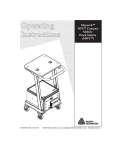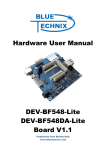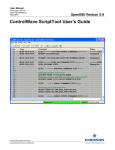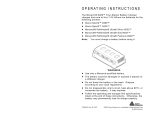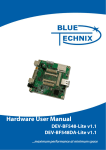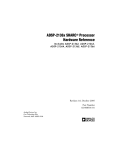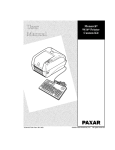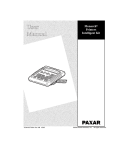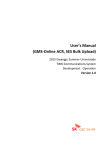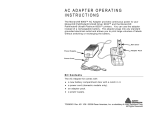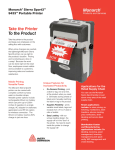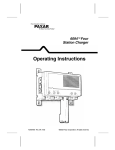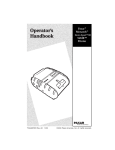Download Paxar Mobile Work Station (MWS) Monarch 9876 User's Manual
Transcript
Operating & Maintenance Instructions TC9876OI Rev. AJ 12/07 Monarch™ 9876™ Mobile Work Station (MWS™) ©2007 Paxar Americas, Inc. a subsidiary of Avery Dennison Corp. All rights reserved. Each product and program carries a respective written warranty, the only warranty on which the customer can rely. Paxar reserves the right to make changes in the product, the programs, and their availability at any time and without notice. Although Paxar has made every effort to provide complete and accurate information in this manual, Paxar shall not be liable for any omissions or inaccuracies. Any update will be incorporated in a later edition of this manual. ©2007 Paxar Americas, Inc. a subsidiary of Avery Dennison Corp. All rights reserved. No part of this publication may be reproduced, transmitted, stored in a retrieval system, or translated into any language in any form by any means, without the prior written permission of Paxar Americas, Inc. WARNING This equipment has been tested and found to comply with the limits for a Class A digital device, pursuant to Part 15 of the FCC Rules. These limits are designed to provide reasonable protection against harmful interference when the equipment is operated in a commercial environment. This equipment generates, uses, and can radiate radio frequency energy and, if not installed and used in accordance with the instruction manual, may cause harmful interference to radio communications. Operation of this equipment in a residential area is likely to cause harmful interference in which case the user will be required to correct the interference at his own expense. CANADIAN D.O.C. WARNING This digital apparatus does not exceed the Class A limits for radio noise emissions from digital apparatus set out in the Radio Interference Regulations of the Canadian Department of Communications. Le présent appareil numérique n’émet pas de bruits radioélectriques dépassant les limites applicables aux appareils numériques de la classe A prescrites dans le Réglement sur le brouillage radioélectrique édicte par le ministère des Communications du Canada. Trademarks MONARCH® and 9876 are registered trademarks of Paxar Americas, Inc. Paxar® is a trademark of Paxar Corporation. Avery Dennison® is a trademark of Avery Dennison Corporation. Avery Dennison Printer Systems Division 170 Monarch Lane Miamisburg, OH 45342 TA B L E O F C O N T E N T S GETTING STARTED . . . . . . . . . . . . . . . . . . . . . . . . . . . . . . . . . . . . . . . . . . . . . . . . . . . 1-1 Using this Manual . . . . . . . . . . . . . . . . . . . . . . . . . . . . . . . . . . . . . . . . . . . . . . . 1-1 Safety Precautions . . . . . . . . . . . . . . . . . . . . . . . . . . . . . . . . . . . . . . . 1-1 Audience. . . . . . . . . . . . . . . . . . . . . . . . . . . . . . . . . . . . . . . . . . . . . . . . . . . . . . 1-2 Ordering Programmer’s Manuals . . . . . . . . . . . . . . . . . . . . . . . . . . . . . . . . . . . 1-2 Calling Service . . . . . . . . . . . . . . . . . . . . . . . . . . . . . . . . . . . . . . . . . . . . . . . . . 1-2 ABOUT THE MWS . . . . . . . . . . . . . . . . . . . . . . . . . . . . . . . . . . . . . . . . . . . . . . . . . . . . . 2-1 Tools You May Need . . . . . . . . . . . . . . . . . . . . . . . . . . . . . . . . . . . . . . . . . . . . . 2-1 Handle Options . . . . . . . . . . . . . . . . . . . . . . . . . . . . . . . . . . . . . . . . . . . . . . . . . 2-2 Shelf Options . . . . . . . . . . . . . . . . . . . . . . . . . . . . . . . . . . . . . . . . . . . . . . . . . . 2-3 About the Doors . . . . . . . . . . . . . . . . . . . . . . . . . . . . . . . . . . . . . . . . . . . . . . . . 2-4 Attaching the Hanging Folders . . . . . . . . . . . . . . . . . . . . . . . . . . . . . . . . . . . . . 2-5 Connecting the Power Cord . . . . . . . . . . . . . . . . . . . . . . . . . . . . . . . . . . . . . . . 2-6 Connecting a Printer . . . . . . . . . . . . . . . . . . . . . . . . . . . . . . . . . . . . . . . . . . . . . 2-7 Using other Monarch Printers . . . . . . . . . . . . . . . . . . . . . . . . . . . . . . . 2-7 Using other Printers . . . . . . . . . . . . . . . . . . . . . . . . . . . . . . . . . . . . . . 2-7 CHARGING THE BATTERIES . . . . . . . . . . . . . . . . . . . . . . . . . . . . . . . . . . . . . . . . . . . . 3-1 Important Charging Information . . . . . . . . . . . . . . . . . . . . . . . . . . . . . . . . . . . . 3-2 About the Battery Charger . . . . . . . . . . . . . . . . . . . . . . . . . . . . . . . . . 3-3 Important Battery Safety Information . . . . . . . . . . . . . . . . . . . . . . . . . . . . . . . . 3-3 Battery Life . . . . . . . . . . . . . . . . . . . . . . . . . . . . . . . . . . . . . . . . . . . . . . . . . . . . 3-4 Frequency of Charging/Run-Time Guidelines . . . . . . . . . . . . . . . . . . . . . . . . . . 3-6 Changing Fuses . . . . . . . . . . . . . . . . . . . . . . . . . . . . . . . . . . . . . . . . . . . . . . . . 3-7 About the Charger’s Fuse . . . . . . . . . . . . . . . . . . . . . . . . . . . . . . . . . . 3-7 Table of Contents i POWER OPTIONS . . . . . . . . . . . . . . . . . . . . . . . . . . . . . . . . . . . . . . . . . . . . . . . . . . . . . 4-1 Standard or Symbol 24VDC . . . . . . . . . . . . . . . . . . . . . . . . . . . . . . . . . . . . . . . 4-1 24VDC/115VAC Power Inverter . . . . . . . . . . . . . . . . . . . . . . . . . . . . . . . . . . . . 4-3 AC/DC Output (Power Inverter) . . . . . . . . . . . . . . . . . . . . . . . . . . . . . . . . . . . . 4-5 About the Inverter . . . . . . . . . . . . . . . . . . . . . . . . . . . . . . . . . . . . . . . . 4-5 Inverter LED Status . . . . . . . . . . . . . . . . . . . . . . . . . . . . . . . . . . . . . . 4-7 Using the Remote Switch . . . . . . . . . . . . . . . . . . . . . . . . . . . . . . . . . . 4-8 Printing . . . . . . . . . . . . . . . . . . . . . . . . . . . . . . . . . . . . . . . . . . . . . . . . . . . . . . . 4-8 About Sleep Mode . . . . . . . . . . . . . . . . . . . . . . . . . . . . . . . . . . . . . . . . . . . . . . 4-9 SPECIFICATIONS . . . . . . . . . . . . . . . . . . . . . . . . . . . . . . . . . . . . . . . . . . . . . . . . . . . . . A-1 Utility Cart . . . . . . . . . . . . . . . . . . . . . . . . . . . . . . . . . . . . . . . . . . . . . . . . . . . . A-1 Batteries . . . . . . . . . . . . . . . . . . . . . . . . . . . . . . . . . . . . . . . . . . . . . . . . . . . . . A-1 Charger . . . . . . . . . . . . . . . . . . . . . . . . . . . . . . . . . . . . . . . . . . . . . . . . . . . . . . A-2 Inverter . . . . . . . . . . . . . . . . . . . . . . . . . . . . . . . . . . . . . . . . . . . . . . . . . . . . . . A-2 WIRING DIAGRAMS . . . . . . . . . . . . . . . . . . . . . . . . . . . . . . . . . . . . . . . . . . . . . . . . . . . B-1 Standard 24VDC . . . . . . . . . . . . . . . . . . . . . . . . . . . . . . . . . . . . . . . . . . . . . . . B-2 Symbol 24VDC. . . . . . . . . . . . . . . . . . . . . . . . . . . . . . . . . . . . . . . . . . . . . . . . . B-3 WM 24VDC (DC/DC Converter) . . . . . . . . . . . . . . . . . . . . . . . . . . . . . . . . . . . . B-4 24VDC/115VAC Power Inverter . . . . . . . . . . . . . . . . . . . . . . . . . . . . . . . . . . . . B-5 24VDC/115VAC 1000W Power Inverter . . . . . . . . . . . . . . . . . . . . . . . . . . . . . . B-6 ii Table of Contents 1 G E T T I N G S TA R T E D Use the Monarch® 9876™ Mobile Work Station™ (MWS™) for mobile printing. Using This Manual Following is a summary of the contents of this manual. Chapter Contents 1 Getting Started Contains information about the batteries and MWS. 2 About the MWS Describes how to connect power cords and use additional devices on the MWS. 3 Charging the Batteries Describes how to charge the batteries. 4 Power Options Describes battery power and battery safety issues. 5 Printing Explains how to print supplies from a printer on the MWS. A Specifications Technical specifications about the MWS. Safety Precautions Following symbols are used in this manual to show importance of using the MWS safely. WARNING Failure to follow the guidelines marked with this symbol could result in serious personal injury or death. CAUTION Failure to follow the guidelines marked with this symbol could result in minor personal injury or product damage. Caution, risk of electrical shock. Also known as the "High Voltage" symbol. Getting Started 1-1 Audience This manual is designed for the person using the MWS for mobile printing applications. After you receive the MWS, you should have all the necessary parts, including the batteries and charger. Check inside ALL packaging material. Make sure you do not throw away any pieces. Keep the boxes and packaging material in case the MWS ever needs repair. Ordering Programmer ’s Manuals The Packet Reference Manual, which describes how to create format and batch packets for printing labels, how to configure a Monarch® printer online, and how to perform other advanced techniques is available from our Web site. Calling Service If these solutions do not work or you have a problem not listed, see your System Administrator or call Service at the number listed on the back of this manual. 1-2 Getting Started 2 ABOUT THE MWS The Mobile Work Station ships mostly assembled. This chapter explains the different options and how to assemble any special options, such as the hanging folders. To o l s Yo u M a y N e e d To assemble the options, you may need a flathead (common) screwdriver; a Phillips screwdriver; wrenches: 7/16", 11/32", 1/4" and adjustable; 5/32" Hex key (wrench); a rubber mallet and hammer, and slip-joint or needle-nose pliers. Check inside ALL packaging material. Make sure you do not throw away any pieces. Front of MWS Left Side Back of MWS Right Side About the MWS 2-1 Handle Options There are different handle configurations and each option is pictured below. One Curved Handle You can have one or two curved handles. Two Curved Handles 2-2 About the MWS Shelf Options You can have one or two shelves. Shelf To collapse the shelf, lift the shelf from the sides and allow it to swing down. To extend the shelf, lift the shelf until the rear lip slides down onto the top of the support brace and locks in place. About the MWS 2-3 About the Doors The MWS has combinations of doors and solid panels that do not open. The doors should already be attached to the MWS. Use water or a glass and surface cleaner to clean the doors/panel. Do not use solvents on these doors/panel. A solvent will damage the door/panel. Doors Doors 2-4 About the MWS Attaching the Hanging Folders Follow the steps below to attach the hanging folders to the MWS. Doors must be installed before you can use the hanging folder option. You must attach the bottom folder to the MWS first. 1. Remove the following items from their packaging: (2) hanging folders (4) Philips screws 2. Locate the holes in the left-side panel. Using a Philips screwdriver, start threading two screws in the two bottom holes. 3. Hang the bottom folder onto the screws. Tighten the screws. 4. Thread two screws in the top two holes. 5. Hang the top folder onto the screws. Tighten the screws. About the MWS 2-5 Connecting the Power Cord Make sure to set the proper voltage on the charger voltage selector switch on the right side of the charger (115V in U.S. or 230V International). Incorrect voltage selection can result in charger failure. Connect the charger's power cord to the power inlet. Power cords are not included with International models. The charger's power switch is also on the right side. Charger Power Switch Power Cord Voltage Selector 115 24VDC Charger Power Inlet The battery's status LEDs are located on the left side of the Power Panel. The MWS Power Switch is to the right of the LEDs. See Chapter 3, "Charging the Batteries" for more information. MWS Power Switch Battery Status LEDs Power Panel Do not plug the external power cord into a wall outlet until you are ready to charge the battery. See Chapter 3, "Charging the Batteries" for important battery information. 2-6 About the MWS Connecting a Printer Contact your Monarch Representative for instructions on attaching a Monarch® printer to the MWS. Using other Monarch® Printers Contact your Monarch Representative for instructions on connecting Monarch® 9462™ and Monarch® 9465™ chargers to the MWS. This allows you to keep the chargers close to where you are working on the sales floor. For more information about using your 9462 or 9465 charger, refer to the Operating Instructions provided with the charger. The following printers are supported with these chargers: u Monarch® Sierra Sport2™ (9460™) u Monarch® Sierra Sport3™ (9433™) u Monarch® Pathfinder® Ultra® Silver (6032™) u Monarch® Pathfinder® Ultra® Platinum (6039™) Additionally, a laptop or handheld computer (terminal) can be powered on the MWS. Using other Printers Contact your Monarch Representative to attach non-Monarch printers to the MWS. About the MWS 2-7 2-8 About the MWS C H A R G I N G T H E B AT T E R I E S 3 This chapter describes how to u charge the Mobile Work Station’s batteries u change the fuses. The battery charger is a fully automatic, maintenance-free charger. Make sure the voltage selector switch (located on the back of the charger) is set for the proper voltage (115V or 220V). Dispose of used batteries according to the manufacturer’s instructions. To charge the battery, plug the Mobile Work Station’s AC power cord into a grounded outlet. Charge the battery: u before using the MWS for the first time (charge it for 7 hours) u when the MWS beeps (see “Battery Life” for indications of low battery conditions) u when the MWS is not in use. When the MWS is not in use, always leave the battery charger plugged in and charging. The battery charger is “intelligent;” it monitors the battery condition and does not overcharge the lead acid battery. Battery life is extended by frequent charging. CAUTION Only qualified service personnel may install or replace the two 12-volt (55 amp-hours) sealed lead-acid non-venting batteries on the MWS. If replacing batteries, you must use the same type of battery from the same manufacturer (as the ones provided with the MWS). Make sure the batteries are NRTL-recognized. Also, BOTH batteries MUST be replaced at the same time to maintain capacity match. Charging the Batteries 3-1 Important Charging Information WARNING DANGER! RISK OF ELECTRICAL AND FIRE HAZARD. CERTAIN ACTIONS MAY RESULT IN DEATH, SERIOUS INJURY, SHOCK, OR BURNS. u Do not disassemble the battery charger. u Do not operate the charger if it has been damaged in any way. Do not spill liquids into the charger, such as water or soft drink. u Do not expose the battery charger to rain or snow. Never charge a frozen battery. The colder the battery, the longer it takes to charge. u Plug only into a three-prong grounded outlet. Do not alter the AC power cord or plug provided. Do not operate the battery charger with a damaged cord or plug. u Do not let the battery remain fully or partly discharged for a long time; keep it charged. u If using an extension cord, you must use 18 gauge or heavier for lengths up to 50 feet, or 16 gauge or heavier for lengths up to 100 feet. Use of improper extension cord could cause fire and electric shock. Use an extension cord bearing the UL listing mark and rated for four Amperes or greater current capacity. u Pull on the plug rather than the cord when disconnecting the battery charger. Locate the cords where they will not be stepped on, tripped over, or otherwise subjected to damage or stress. u The batteries must be charged when the total voltage is less than 21V. The charger will not charge if the total voltage is less than 5V. If the total voltage is less than 5V, you need new batteries. 3-2 Charging the Batteries About the Battery Charger u Store the charger in a dry area not subject to prolonged sub-zero temperatures. u The battery charger is “intelligent;” it monitors the batteries condition and does not overcharge the batteries. It is recommended to leave the battery charger plugged in and charging when the Station is not in use. Battery life is extended by frequent charging. u The charger’s Power On light is on when all the connections are correct. u The charger’s Green Full Charge light is on when the battery is finished charging. Leaving the charger plugged in prevents the battery from self-discharging. Important Battery Safety Information u Never smoke or allow a spark or flame in vicinity of battery. u Do not drop a metal tool on the battery. The resulting spark or short-circuit on the battery of other electrical part may cause an explosion. u Remove personal metal items such as rings, bracelets, necklaces, and watches when working with a lead-acid battery. A lead-acid battery produces a short-circuit current high enough to weld a ring to metal, causing a severe burn. Charging the Batteries 3-3 Battery Life If you leave the battery charger plugged in and constantly charging when the MWS is not in use, the battery life is maximized for the application. The charger will not overcharge the batteries. The MWS has signal lights to indicate the battery status as follows. The following voltages are nominal (not exact) and should be used for reference. Charger Status LEDs Flashing Red Warning! The batteries need immediate charging. Voltage is below 22.5V. The station beeps continuously to alert you of this condition. (Early models have red lights instead of orange lights.) Flashing Yellow Caution! The batteries are getting low. The voltage is between 22.5V and 23.5V. Flashing Green Go! The voltage is above 23.5V. The batteries are charged to approximately 75% or better capacity. The 24VDC charger has a Power LED and five Percentage LEDs. When the charger is turned off (power LED off), the percentage LED shows battery status. The percentage LED flashes while charging to display battery status. When the batteries are fully charged, the 100 percent LED stays on. 100% Power LED 85% 70% 50% 30% 1 Percentage LED If the CHARGE light does not turn on, make sure the charger is properly connected to the batteries and the charger has AC power. If the READY light does not turn on after 18 hours, the batteries are deeply discharged. Call Technical Support or replace the batteries. If replacing batteries, you must use the same type of battery from the same manufacturer (as the ones provided with the MWS). Make sure the batteries are NRTL-recognized. Also, BOTH batteries MUST be replaced at the same time to maintain capacity match. 3-4 Charging the Batteries F r e q u e n c y o f C h a r g i n g / R u n -T i m e G u i d e l i n e s The following information is approximate and should be used for reference. Many factors effect an individual battery’s performance: u the presence of auxiliary devices u the printing rate (including printhead contrast and number of labels per day) u the complexity of your printed formats u the environment (temperature and humidity in your facility or DC). In the information below, “typical conditions” are as follows: one Monarch printer printing standard compliance 4x6 labels (5-10 minutes of actual printing per hour), no auxiliary devices attached to the MWS, and standard environmental conditions (no excessive heat or humidity). u When using the 24VDC or Symbol 24VDC MWS under typical conditions, the batteries may last up to 50 to 100 hours before recharging. u When using the AC Power Inverter or 24VDC/115VAC MWS under typical conditions, the batteries may last up to 24 hours before recharging. u When you notice the batteries need to be charged more frequently, order replacement batteries. BOTH batteries MUST be replaced at the same time to maintain capacity match. For example, if you had 60 hours of use between charges and now have 30 hours of use between charges, replace the batteries. The performance of your batteries varies depending on the number of printers and/or auxiliary devices, such as a scanner or terminal, attached to the MWS. Frequent charging of the batteries is recommended. Charging the Batteries 3-5 Changing Fuses There are two fuses for the MWS: one connecting the batteries and one from BAT2 to the terminal block. Depending on the power option selected when you ordered the MWS, the size of the fuses varies. See Chapter 4, “Power Options,” for more information. WARNING You may observe a spark when you make this connection since current flows to charge capacitors in the power inverter. Do not make this connection in the presence of Flammable fumes. Explosion or fire may result. CAUTION The power switch on the front of the MWS must be off while changing fuses. (The status light near the power switch should be OFF.) 1. Turn the MWS’ power supply off and unplug the power cord. 2. Open the cabinet. 3. Unplug the fuses from the fuse holders. 4. Insert the proper voltage fuse in each fuse holder. Each fuse is labeled as 20A or 30A. Fuse Description F1 20 A ATO (from BAT2 to the terminal block) F2 20 A ATO (connects the batteries only for the DC power option) 30 A ATO (for the 300W, 24VDC Power Inverter option) About the Charger ’s Fuse The charger (12V or 24V) inside the MWS also has a fuse: T4A 125V fuse (for 12V chargers) or T6A 125V fuse (for 24V chargers). 3-6 Charging the Batteries 4 POWER OPTIONS Your MWS was ordered with one of these power options: u Standard 24VDC u Symbol 24VDC u 24VDC/115VAC (uses the power inverter for AC power. The power inverter is only 115V.) u AC/DC Output with the power inverter. The power inverter is only 115V. Make sure all packaging material is removed from the cabinet before use. Standard or Symbol 24VDC 20 Amp Fuse Jumper Connect, F2 Black Wires 20 Amp Fuse, F1 BAT 2 BAT 1 BlackWire (-) to Terminal Block Green Wire Ground to Station Floor Red Stripe Wire to Terminal Block Power Options 4-1 Check the wiring for your batteries and charger. Battery Strap Battery Support Ground Wires Make sure the ground wire is attached using one M5 screw with two M4 nuts and M4 washers as shown. Keep the Mobile Work Station’s power switch ON when continuously operating the MWS and/or printer(s). If the MWS will be unused for extended periods of time, turn OFF the Mobile Work Station’s power switch. The MWS’ power switch controls the power to all printers. If using more than one printer on the MWS, manually turn OFF each printer’s power switch. 4-2 Power Options 24VDC/115VAC Power Inverter The AC power inverter is only 115V. The AC power inverter uses battery power, so the batteries may require more frequent charging. WARNING Remove ALL fuses from the cables before connecting ANY cables to the batteries or switch. Make sure all the DC connections are tight (torque to 9-10 ft-lbs, 11.7-13 Nm). Loose connections overheat and could result in a potential hazard. Check the wiring for your batteries and charger. 30 Amp Fuse Jumper Connect, F2 Red Wire to Inverter BAT 2 20 Amp Fuse, F1 BAT 1 Black Wire (-) to Terminal Block Green Wire Ground to Station Floor Red Stripe Wire to Terminal Red Wire to Terminal Block Make sure the proper voltage fuse is installed in each fuse holder. Each fuse is labeled as 20A or 30A. The batteries are connected with a 30 Amp fuse BAT2 has a 20 Amp fuse from it to the terminal block. Power Options 4-3 Make sure the ground wires are attached using one M5 screw with two M4 nuts and M4 washers as shown. Battery Strap Battery Support Ground Wires WARNING This equipment contains components which can produce arcs or sparks. To prevent fire or explosion, do not install near Flammable materials or in locations that require ignition-protected equipment (including gasoline-powered machinery, fuel tanks, joints, or fittings). 4-4 Power Options AC/DC Output (Power Inverter) Uses the power inverter for AC power, along with the standard 24VDC for a Paxar/Monarch printer. The power inverter is only 115V. The AC power inverter uses battery power, which may require more frequent charging of the batteries. About the Inverter WARNINGS The inverter is designed to operate from a battery. Performance cannot be guaranteed and damage can result when the inverter is ran without the batteries installed! Even if the MWS is not connected to an outlet, power is still supplied to the inverter from the batteries and charger. Therefore, all cables are always "live." You may observe a spark when you make this connection since current flows to charge capacitors in the power inverter. Do not make this connection in the presence of Flammable fumes. Explosion or fire may result. Remove ALL fuses from the cables before connecting ANY cables to the batteries or switch. Make sure all the DC connections are tight (torque to 9-10 ft-lbs, 11.7-13 Nm). Loose connections overheat and could result in a potential hazard. Power Options 4-5 Check the connections between the inverter’s cables, the batteries and the inverter’s switch as follows: heavy-gauge heavy-gauge orange cable orange cable red cable assembly to positive (+) on BAT2 black cable to negative (-) on BAT1 to pole on switch to Remote (RMT) on switch None of the inverter’s cables are attached the terminal block. Orange, Pole Orange, RMT Switch on the MWS Electrical Panel 4-6 Power Options WARNING You may observe a spark when you make this connection since current flows to charge capacitors in the power inverter. Do not make this connection in the presence of Flammable fumes. Explosion or fire may result. Operation of the inverter without a proper ground connection may result in an electrical safety hazard. Do not store anything inside the cabinet other than the batteries and battery charger. The cabinet must remain locked at all times and the key must be stored with qualified service personnel. Inverter LED Status Display Input Voltage LED Status DC 24V GREEN (solid) AC Power OK RED Blink (fast) Over-voltage protect 30.6 RED Blink (slow) under-voltage protect 21.0 RED Blink (intermittent) over-temperature protect _ RED (solid) over-load protect >400W / 960W Power Options 4-7 Using the Remote Switch The Mobile Work Station’s On/Off switch should be used as a remote switch to turn the inverter ON or OFF. To do this: 1. On the inverter’s front panel, set the ON/OFF/REMO switch to OFF or REMO. Set to OFF/REMO 2. Make sure the switch on the electrical panel is OFF. 3. Make sure the orange wires are connected to the Remote Port (on the inverter) and the RMT Switch on the electrical panel. Printing To print supplies from a Monarch printer on the MWS: 1. Turn on the Mobile Work Station’s power supply and turn on the printer. PRINT MODE Ready B 2. Press Feed/Cut to calibrate the supply. You are now ready to collect data and print. 4-8 Power Options To conserve the battery, make sure the Mobile Work Station’s power switch is turned OFF when not in use OR when charging the batteries. For optimal (shortest) charging time, turn off the MWS and printer while charging. u If you need to finish a batch, you can print while charging, as long as the batteries are not too depleted. However, printing while charging is not recommended on a frequent basis. u If the printer will be unused for extended periods of time, we recommend leaving the printhead unlatched. u If the printer’s green power light blinks, you need to recharge the battery. There is a small reserve of battery power to continue printing after the green power light begins blinking. u You must recharge the battery when you see error 762 or “Battery Dead” on the display because the printer is in a “lock-up” condition and does not print until the battery is recharged. u The printer may slow down if the battery voltage drops below a certain level. The printer continues to print at the reduced speed until the batteries are charged and the printer is turned off and then back on. See “Battery Life” in Chapter 3 for more information about charging the batteries. About Sleep Mode If the Monarch printer is inactive for longer than 30 seconds, the printer goes into sleep mode to conserve battery power. While in sleep mode, the display backlight is turned off to conserve battery power. Once the printer “wakes up,” the backlight turns on. To “wake up” the printer, press any button on the control panel. The buttons are active during sleep mode, so if you press Escape/Clear, the printer “wakes up” and you enter the offline menu mode. You can also send any data to the printer to wake it up. You do not lose any data sent to the printer during sleep mode. Power Options 4-9 4-10 Power Options A S P E C I F I C AT I O N S Utility Cart Height Approximately 42 inches (1067 mm) depending on selected options Width 23 inches (584 mm) Length 28 inches (711 mm) Weight Approximately 150 lbs (68 kg) depending on selected options Operating Limits 40°F to 95°F (5°C to 43°C) with thermal transfer supplies Storage: 15°F to 120°F (-9°C to 49°C) Humidity: 5% to 90% non-condensing Batteries u (2) 12-volt, 55 amp-hours, deep cycle batteries u Sealed lead-acid, non-venting (safety venting only), no transportation restrictions u Shelf Life/Charge Retention: 1 month 3 months 6 months u 97% 91% 85% Cycle Use: 100% depth of discharge 50% depth of discharge 30% depth of discharge approx. 250 cycles approx. 550 cycles approx. 1200 cycles Cycle Life is approximate and many factors effect an individual battery’s performance. Specifications A-1 Charger Input 117VAC 60Hz, 320VA (Volt Amps) Output 24 Volts, 8 Amps DC u Electronic reverse polarity and short circuit-shutdown u Low voltage start (total battery voltage must be greater than 1V to charge) u AC input fuse in AC input connector Use only NRTL-listed accessories (National Recognized Testing Lab). Inverter Input Voltage 21 to 30VDC No Load Current 0.23A Frequency 60 Hz Output Voltage 110VAC +5% Output Power 300W RMS (continuous) Surge Power 400W RMS (1 second) Output Waveform Pure Sine Wave (THD<4%) Typical Effeciency 75% Operating Temperature 32°F to 105°F (0°C to 40°C) A-2 Specifications B WIRING DIAGRAMS This appendix contains wiring diagrams for the various power options: u Standard 24VDC u Symbol 24VDC u WM 24VDC (DC/DC Converter) u 24VDC/115VAC Power Inverter WARNING Only qualified service personnel may install or replace the two 12-volt sealed lead acid batteries used to power the printer on the Station. If a battery needs to be replaced, BOTH batteries MUST be replaced at the same time to maintain capacity match. One or two power sparks may occur (this is normal) when installing or changing the fuses. Wiring Diagrams B-1 B-2 Wiring Diagrams 126523 126523 126491 or 126803 124589 L G N Standard 24VDC 126763 126523 126523 126678 126759 126762 126490 126491 or 126803 126769 126624 126490 126679 126768 L G N 126575 126679 126679 126761 126471 126769 126473 Symbol 24VDC Wiring Diagrams B-3 BATTERY JUMPER CONNECT 30 AMP FUSED (F2) PART# 124845 30 B-4 Wiring Diagrams ATO AMP fuse Batt. #1 PART# 126523 Batt. #2 PART# 126523 DC to DC converter 125393 117592 GND HARNESS BATTERY wire wire GREEN Black 20 AMP ATO fuse BLACK WIRE 124587 MAIN PWRMINUS 124592 HARNESS, FUSED 20A MAIN (F1) CHARGER PART# 125358 or 126803 CHARGER HARNESS (ATTACHED TO CHARGER) 117597 JUMPER GRN/YEL +24V 24V_SW NOT USED GND TERM. BLCK RED/BLK OR RED WIRE PART# 124930 PRINTER & RELAY PWR HARNESS "PRT PWR" Red wire 125391 Black wire 125392 wire FUSED 118721 JUMPER SAFETY GND 124586 IEC CORD CHARGER TO INLET BLUE L BROWN G 117597 JUMPER 119262 IEC INLET SWITCH #124828 N 86 85 BATTERY STATUS BOARD 124602 + 124930 PRINTER &RELAY PWR HARNESS "AUX PWR" 124591 BATTERY STATUS BD HARNESS 124924 117597 JUMPER 30 87 supply for terminal 125390 WM 24VDC (DC/DC Converter) 126763 126766 126765 126523 126523 125584 126678 126759 126762 126767 126764 126764 126491 or 126803 126624 126490 126681 126679 126575 126679 126761 126764 126764 126473 24VDC/115VAC Power Inverter Wiring Diagrams B-5 Visit www.paxar.com for sales, service, supplies, information, and telephone numbers for our locations throughout the world. TOLL FREE: 1-800-543-6650 (In the U.S.A.) 1-800-363-7525 (In Canada)






































